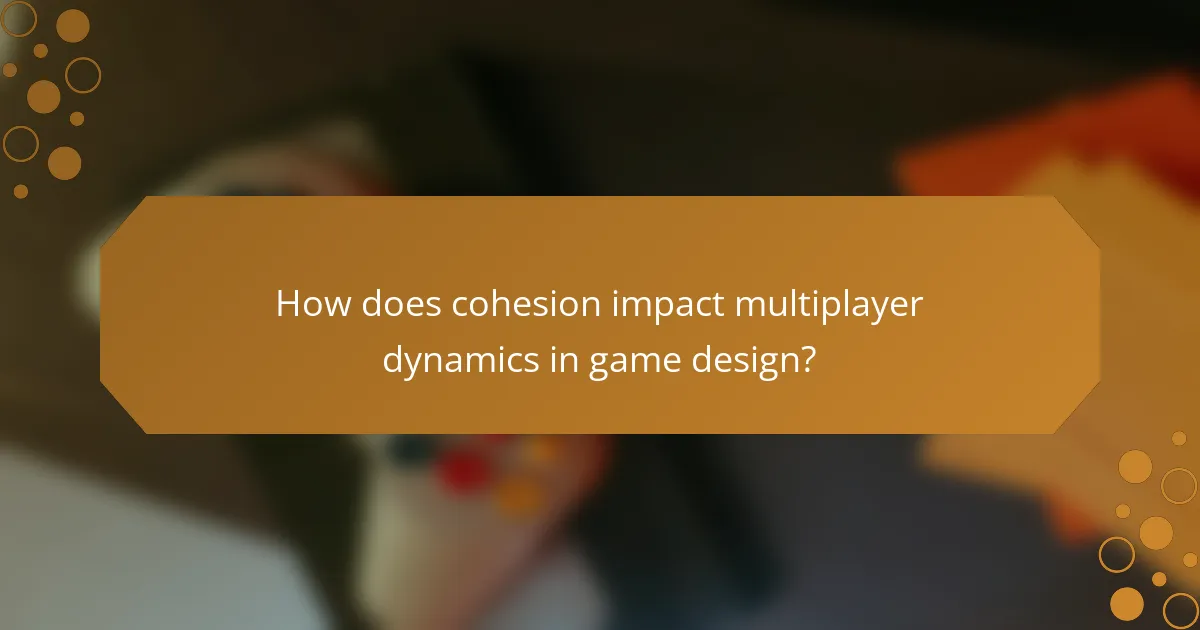Cohesion plays a crucial role in enhancing multiplayer dynamics by aligning gameplay elements, narratives, and player interactions. This alignment not only fosters effective collaboration among players but also deepens their immersion in the game world. By maintaining narrative consistency through cohesive lore and character development, developers can significantly enhance player experience and engagement, making every interaction meaningful.

How does cohesion impact multiplayer dynamics in game design?
Cohesion significantly enhances multiplayer dynamics by ensuring that gameplay elements, narratives, and player interactions are aligned. This alignment fosters a more engaging and seamless experience, allowing players to collaborate effectively and immerse themselves in the game world.
Enhanced player collaboration
Cohesion in game design promotes enhanced player collaboration by creating a unified experience where players can easily understand their roles and objectives. When game mechanics and narratives are consistent, players are more likely to work together towards common goals, leading to improved teamwork.
For example, in cooperative games, clear communication about tasks and objectives can be facilitated through cohesive design elements, such as shared resources or synchronized abilities. This clarity helps players strategize effectively, reducing confusion and increasing overall satisfaction.
Improved game immersion
Improved game immersion arises from cohesive design, as players feel more connected to the game world and its story. When the narrative, visuals, and mechanics are harmonized, players can lose themselves in the experience, making it more enjoyable and memorable.
To achieve this, developers should ensure that all aspects of the game, from character design to environmental storytelling, reflect the same themes and aesthetics. For instance, a fantasy game with consistent lore and visual style can draw players deeper into its world, enhancing their emotional investment.
Stronger community building
Cohesion fosters stronger community building by creating a shared experience that players can discuss and engage with. When players feel connected through a common narrative and gameplay mechanics, they are more likely to form lasting relationships and communities around the game.
Encouraging players to share their experiences through forums, social media, or in-game events can amplify this effect. Developers can support community growth by hosting regular updates or events that align with the game’s cohesive elements, keeping players engaged and connected over time.

What are effective strategies for maintaining narrative consistency?
Effective strategies for maintaining narrative consistency in multiplayer environments include creating a cohesive lore, ensuring character arcs align with the overall story, and establishing clear rules for the world. These elements work together to enhance player experience and engagement.
Utilizing shared lore
Shared lore serves as the backbone of narrative consistency, providing a common history and context for all players. This can include myths, historical events, and cultural elements that are accessible and relevant to the gameplay. For example, a fantasy game might have a detailed mythology that players can reference, enriching their interactions.
To implement shared lore effectively, consider creating a central repository, such as a wiki or a dedicated in-game library, where players can explore and contribute to the lore. Regular updates and community involvement can keep the lore dynamic and engaging.
Implementing consistent character arcs
Consistent character arcs are crucial for maintaining narrative integrity. Each character should have a clear trajectory that aligns with the overarching story, allowing players to experience growth and change that feels authentic. For instance, a character who starts as a novice should gradually develop skills and relationships that reflect their journey.
To ensure consistency, outline character development paths early in the design process and communicate these arcs to players. Encourage players to make choices that align with their character’s growth, reinforcing their investment in the narrative.
Establishing clear world rules
Clear world rules help define the boundaries of the narrative and gameplay, ensuring that players understand the mechanics and limitations of the environment. These rules can cover aspects such as magic systems, technology, and social structures. For example, if a game features a magic system, it should have defined limitations to prevent inconsistencies in how magic is used.
To establish effective world rules, create a comprehensive guide that outlines these elements and make it easily accessible to players. Regularly revisiting and refining these rules based on player feedback can help maintain balance and coherence in the narrative.

How can player experience be optimized in multiplayer settings?
Player experience in multiplayer settings can be optimized by focusing on gameplay mechanics, fostering open communication for feedback, and implementing adaptive storytelling. These strategies enhance engagement and ensure that players feel valued and connected to the game world.
Balancing gameplay mechanics
Balancing gameplay mechanics is crucial for maintaining fairness and competitiveness among players. This involves adjusting parameters such as character abilities, weapon strengths, and resource availability to ensure no single player or strategy dominates. Regular updates and patches based on player performance data can help maintain this balance.
Consider using metrics like win rates and player feedback to identify imbalances. For example, if a particular character consistently outperforms others, adjustments may be necessary to level the playing field. Aim for a balance that keeps gameplay challenging yet enjoyable for all skill levels.
Encouraging player feedback
Encouraging player feedback is essential for understanding the community’s needs and preferences. Implementing in-game surveys, forums, or social media channels can provide players with a platform to voice their opinions and suggestions. This feedback loop can lead to improvements that enhance the overall experience.
Consider offering incentives, such as in-game rewards or recognition, for players who provide valuable feedback. Regularly reviewing and acting on this feedback demonstrates that developers value player input, fostering a stronger community and improving player retention.
Integrating adaptive storytelling
Integrating adaptive storytelling allows the narrative to evolve based on player choices and interactions. This approach creates a more immersive experience, as players feel their actions have real consequences within the game world. Dynamic storylines can be achieved through branching narratives or player-driven events.
To implement adaptive storytelling effectively, consider using algorithms that track player decisions and adjust the narrative accordingly. This can lead to diverse experiences within the same game, encouraging replayability and deeper engagement. Ensure that the story remains coherent and relevant to maintain player interest.

What frameworks support cohesive world building?
Cohesive world building is supported by frameworks that integrate narrative design principles and player engagement models. These frameworks ensure that the game’s universe feels consistent and immersive, enhancing the overall player experience.
Narrative design principles
Narrative design principles focus on creating a compelling story that aligns with the game world. Key elements include character development, plot progression, and thematic consistency. Ensuring that these elements are interwoven helps maintain a believable and engaging environment.
For example, a fantasy game might establish a rich lore that informs character motivations and conflicts. This depth encourages players to invest emotionally in the story, enhancing their connection to the world. Consistency in the narrative also helps avoid plot holes that can disrupt immersion.
Player engagement models
Player engagement models are frameworks that analyze how players interact with the game world and its narrative. These models consider factors such as player agency, feedback loops, and social dynamics. Understanding these aspects allows developers to create experiences that resonate with players and encourage ongoing participation.
For instance, providing choices that impact the story can significantly increase player investment. Additionally, incorporating social elements, like multiplayer interactions, can foster a sense of community and shared narrative, further enhancing the cohesive world building.

What tools enhance cohesion in digital world building?
Several tools can significantly enhance cohesion in digital world building by facilitating collaboration, lore management, and narrative consistency among players. Utilizing the right software can streamline the creative process and ensure that all elements of the game world are interconnected and immersive.
Unity for collaborative environments
Unity is a powerful game development platform that enables teams to work together seamlessly on digital worlds. Its collaborative features allow multiple developers to contribute to the same project in real-time, ensuring that assets, scripts, and environments remain consistent across the board.
When using Unity, consider implementing version control systems like Git to manage changes effectively. This helps prevent conflicts and maintains a cohesive vision of the game world. Additionally, leveraging Unity’s Asset Store can provide ready-made assets that enhance the richness of your environment without starting from scratch.
World Anvil for lore management
World Anvil is an online tool designed specifically for world-building and lore management, making it ideal for maintaining narrative consistency. It allows creators to document characters, locations, and histories in an organized manner, ensuring that all elements of the story are easily accessible and interconnected.
To maximize World Anvil’s potential, regularly update your lore as the game evolves and encourage player contributions to enrich the narrative. Utilizing its features like timelines and relationship maps can help visualize connections and enhance player engagement with the world.

How do cultural influences shape multiplayer narratives?
Cultural influences significantly shape multiplayer narratives by affecting the themes, character development, and player interactions within the game. These narratives often reflect the values, beliefs, and social norms of different cultures, creating a rich tapestry that enhances player engagement and experience.
Understanding cultural context
Understanding cultural context is crucial for developing multiplayer narratives that resonate with players. Different cultures have unique storytelling traditions, symbols, and moral frameworks that can influence how narratives are constructed and perceived. For example, a game set in a culture that values community may emphasize teamwork and collaboration, while one rooted in individualism might highlight personal achievement.
Incorporating diverse perspectives
Incorporating diverse perspectives into multiplayer narratives can enhance the richness of the gaming experience. This can be achieved by including characters from various backgrounds, each bringing their own cultural narratives and viewpoints. Games like “Overwatch” and “League of Legends” showcase characters with distinct cultural identities, which not only broadens the appeal but also fosters inclusivity among players.
Balancing authenticity and accessibility
Balancing authenticity and accessibility is essential when integrating cultural influences into multiplayer narratives. While it’s important to represent cultures accurately, developers must also ensure that the content is approachable for a global audience. This can involve simplifying complex cultural references or providing context through in-game tutorials or lore, allowing players from different backgrounds to engage meaningfully without feeling alienated.



